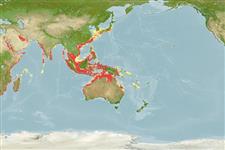Environment / Climate / Range
Ecology
Marine; reef-associated; depth range 3 - 90 m (Ref. 30573). Tropical, preferred ?; 42°N - 34°S, 30°E - 171°E
Indo-Pacific: Persian Gulf (Ref. 68964), Red Sea and East Africa to Papua New Guinea, north to Japan, south to New South Wales, Australia.
Length at first maturity / Size / Weight / Age
Maturity: Lm ?, range 157 - 178 cm
Max length : 300 cm TL male/unsexed; (Ref. 58784); max. published weight: 135.0 kg (Ref. 9987)
An unmistakable guitarfish with a broad, rounded snout, large, high pectoral fins, and heavy ridges of spiky thorns over the eyes and on the back and shoulders; jaws with heavily ridged, crushing teeth in undulating rows (Ref. 5578). Grey or brownish above (Ref. 5578), white below; numerous white spots dorsally on fins, body and tail; black spots on head and shoulders but no eyespots or ocelli (Ref. 3919).
Inhabits coastal areas and on coral reefs, close inshore (Ref. 9915). Found on sand and mud bottoms (Ref. 12951). Sometimes found in the water column (Ref. 12951). Feeds mainly on bottom crustaceans and mollusks (Ref. 9915). Ovoviviparous (Ref. 50449). A row of large spines present above the eye, on the center of the nape, and on the shoulder have a defensive function (can be used for butting). Caught commonly by demersal tangle net, and occasionally trawl and longline fisheries (Ref.58048). Difficult to handle and can damage the catch when caught in trawls (Ref. 9915). Utilized fresh and dried-salted; the pectoral fins are the only part which is eaten (Ref. 9987).
Exhibit ovoviparity (aplacental viviparity), with embryos feeding initially on yolk, then receiving additional nourishment from the mother by indirect absorption of uterine fluid enriched with mucus, fat or protein through specialised structures (Ref. 50449). With 4 in a litter (Ref. 12951). Size at birth 45 cm (Ref. 12951).
Compagno, L.J.V. and P.R. Last, 1999. Rhinidae (=Rhynchobatidae). Wedgefishes. p. 1418-1422. In K.E. Carpenter and V. Niem (eds.) FAO identification guide for fishery purposes. The Living Marine Resources of the Western Central Pacific. FAO, Rome. (Ref. 9915)
IUCN Red List Status (Ref. 115185)
CITES (Ref. 94142)
Not Evaluated
Human uses
Fisheries: commercial
More information
ReferencesAquacultureAquaculture profileStrainsGeneticsAllele frequenciesHeritabilityDiseasesProcessingMass conversion
Tools
Special reports
Download XML
Internet sources
